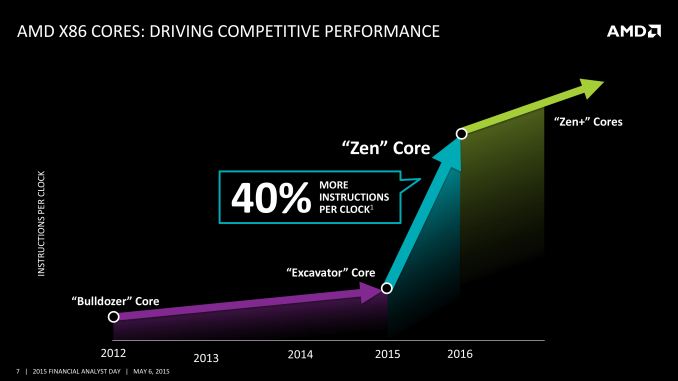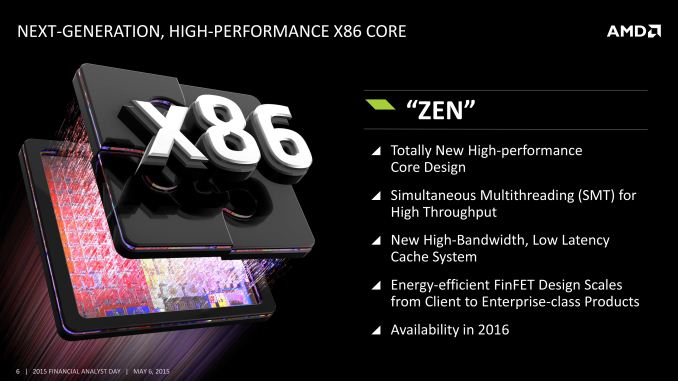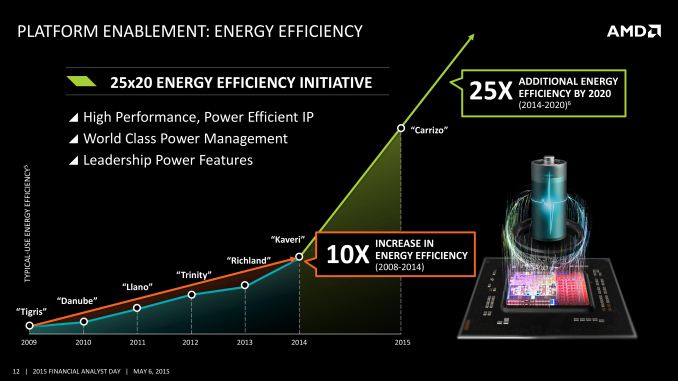AMD’s 2016-2017 x86 Roadmap: Zen Is In, Skybridge Is Out
by Ryan Smith on May 6, 2015 2:02 PM EST- Posted in
- CPUs
- AMD
- AMD FAD 2015
- Zen

AMD’s CTO Mark Papermaster just left the stage at AMD’s 2015 Financial Analyst Day, and one of the first things he covered was AMD’s CPU technology roadmap for the next couple of years.
The big question on everyone’s mind over the last year has been AMD’s forthcoming x86 Zen CPU, developed by Jim Keller’s group, and Papermaster did not disappoint, opting to address the future of AMD’s x86 plans first and foremost. AMD is not releasing the complete details on Zen until closer to its launch in 2016, but today they are providing some basic details on the CPU’s abilities and their schedule for it.
In terms of features, AMD once again confirmed that they’re aiming for significantly higher performance, on the order of a 40% increase in Instruction Per Clock (IPC) throughput. In a significant shift in threading for AMD’s x86 CPUs, Zen will also shift from Bulldozer’s Clustered Multithreading (CMT) to Simultanious Multithreading (SMT, aka Intel’s Hyperthreading). CMT is the basis for Bulldozer’s unusual combination of multiple integer cores sharing a single FPU within a module, so the move to SMT is a more “traditional” design for improving resource usage, and it means Zen will similarly have a more traditional resource layout. AMD is also labeling Zen’s cache as a “high-bandwidth, low latency cache system,” though at this time they aren’t quantifying just how that differs from the Dozer family’s cache.
Meanwhile AMD has confirmed that Zen will be shipping in 2016, and that it will be produced on a yet-to-be-named FinFET process. Our bet would be that AMD continues to use traditional partner (and spin-off fab) GlobalFoundries, who will be ramping up their 14nm equipment for next year as part of their licensing/partnership with Samsung to implement Samsung’s 14nm FinFET process. Zen at this time is AMD’s priority, to the point where the company is willing to push back the ARM K12 in order to get Zen out the door first.
Desktop users will be happy to know that the first Zen processor out the door will be AMD’s high-end desktop CPU (AMD was very deliberate in this, it’s not an APU). AMD will be aiming high and then cascading Zen down into APUs and lower-end products.
Said Zen CPU will use a new AMD platform – AM4 – which will also support DDR4. Unlike the Dozer family, all of AMD’s desktop CPUs will use the same AM4 platform/socket, so when AMD does ramp up their Zen APU, it too will be on AM4 and not its own socket, simplifying the process.
Finally, AMD’s roadmap for Zen over 2016-2017 calls for further improved Zen cores, “Zen+”, later on. Though the biggest jump for AMD comes from the transition from Dozer to Zen, the company is looking to push the envelope on IPC harder than they did with the Dozer family, projecting a higher increase in IPC over time than what we saw with the Dozer parts.
As for what this means for single-threaded performance, that remains to be seen. After having chased a lower-IPC/higher-clockspeed strategy in an attempt to do something different from Intel – the AMD that designed Bulldozer thought it wise not to try to beat well-funded Intel at their own game – the focus on higher IPC is arguably the correct move to make as the laws of physics have continued to keep 5GHz+ clockspeeds from being efficient enough to be practical. That said, single-threaded performance is a combination of IPC and clockspeed, so to be competitive with Intel AMD needs to deliver higher IPC while maintaining relatively high clockspeeds, and the latter is not something AMD is disclosing this early in the process.
Finally, we’ll note that this roadmap is empty of any mentions of project Skybridge. CEO Lisa Su has commented that AMD has decided to change their focus away from Skybridge based on customer feedback. Customers were telling AMD that they didn't necessarily need socket compatible solutions, so AMD is going to work on differentiated solutions. That said, given that Skybridge was announced last year and planned for 20nm, I suspect that it has also become a victim of the short lifespan (and underperforming nature) of 20nm, leading to it being downplayed in favor of 14nm prodcts.
Meanwhile also absent was any further mention of AMD's Cat cores. Zen would appear to be AMD’s top-to-bottom x86 core, a significant departure from an AMD who previously wanted separate designs for the 10W-100W market and sub-10W markets.














59 Comments
View All Comments
chizow - Wednesday, May 6, 2015 - link
You're better when you type nonsense about GPUs with those clown hands of yours.Huge celebration by users when Apps hits page 2? LOL, I guess a library of apps that includes EVERY x86 program ever written isn't enough? Users already celebrated when they realized they actually had a functional OS and platform again when they moved off toy junk OSes Android or iOS. And that's before Microsoft recently announced Android/iOS Apps were so trivial they can just emulate them in x86 Windows 10.
But yes, if AMD can produce anything competitive with either the "broken" Core M or Atom in that <15W market within a year, that will be amazing. Even more amazing than AMD still existing in a year from now.
Crunchy005 - Wednesday, May 6, 2015 - link
I was talking about surface RT? Windows RT is no longer around because the choice of apps for that was very small(page 2 stuff), people didn't like it and it didn't end well. The surface 3 uses an atom because it is x86 and intel gives them away for free not because it is a good chip.lilmoe - Wednesday, May 6, 2015 - link
RT is a great product with the worst timing... It should have been released after the app gap was closed with Universal Apps (NOT Metro) and sold on hardware going for less than $250 to compete with the Chromebook model. Microsoft f'ed up. It would have been the nail in the coffin for every other ARM tablet/hybrid when it comes to value, fluidity, battery life, security, and capability.Crunchy005 - Wednesday, May 6, 2015 - link
Ya the RT wasn't a bad product, it just didn't have the app support it needed and it was pricey. It also didn't really fit into the whole unity thing Microsoft was going for so it makes sense they scrapped it.chizow - Wednesday, May 6, 2015 - link
Ya once again, any Atom chip that can run x86 is going to be better than any ARM-based toy, for the simple fact it can run more than a bunch of toys from an "app" store.Crunchy005 - Thursday, May 7, 2015 - link
@chizow true, only problem is they can't fun facebook/flash games on the web. That was an issue with my friends Mom. He got one of those convertible laptops, budget hence the atom, and it didn't run her facebook games so they returned it. So just curious how many other things they have issues running.chizow - Thursday, May 7, 2015 - link
Atom-based tablets have no problems at all running Flash games, again, if you're going to just make stuff up at least throw something plausible up there.chizow - Wednesday, May 6, 2015 - link
Sure $3-4 Bn per year or $1 Bn per quarter is a small fee when they are posting $6-14 Bn in PROFITS per quarter on the strength of their x86 empire. They are simply investing in the rest of their products by pushing x86 into new markets. So while it is true most readers of this site do not care about the Atom, it was exactly this kind of narrow-focus that got AMD in trouble and shut out of the low-end markets to begin with. In the end, its all about relevance in the marketplace, right now Intel is addressing their biggest risk areas with Atom and Core M.Crunchy005 - Wednesday, May 6, 2015 - link
And it is that "empire" that needs competition to keep pushing innovation. Intels performance gains and architecture has been nothing special since bulldozer came out. Intel could lower prices and probably try a bit harder to push performance but they are fine with mediocre steps until AMD is competitive again(you the consumer are losing out). Also the Atom came around for netbooks and I feel is still broken, hence the 0 interest in it until it was given away by intel. Intel has it's bad spots as well and they mainly have that profit margin because AMD was stupid with bulldozer and lost it's competitive edge. So intel is like lets get a 2% performance gain and sell the new chips for more and not bring prices down on older chips. On top of that their naming scheme is terrible. Everything is i3,i5,i7 and thats what consumers see. So selling older chips for the same price is easier, low blow really. Marketing people ruin everything in the tech world...the not so 4G, 4G LTE anyone?chizow - Wednesday, May 6, 2015 - link
Stopped reading after the 1st sentence. Again, this is more nonsense. Intel has continued to innovate where they are most threatened:1) Low power markets
2) Graphics
If you look at the gains in these two markets, you will see, they have continued to make amazing steps. Compare an Ultrabook or Surface Pro 3 to the Laptops even from Core i7 and tell me there wasn't a HUGE improvement in size, TDP, portability, and battery life in the years since Bulldozer.
Now also look at the iGPU standpoint. Intel, while still pretty poor at graphics, has made huge advancements with their transistor and TDP budgets with Iris Pro and even their GT products. Every generation they make significant 50+% gains there.
So yes, while they have not pushed the envelope much in that mainstream 80-130W desktop market, they still manage to put out nice updates every few years, and on the high-end they are definitely still pushing things because there are some monster chips out there with up to 16 cores!
http://ark.intel.com/products/84681/